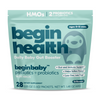Why Only a Few HMOs Are Used in Formula—Even Though Breast Milk Has 200+
share this article

Human milk oligosaccharides (HMOs) are one of the most important components of breast milk when it comes to shaping a baby’s gut microbiome and supporting immune health. With more than 200 distinct HMOs identified in breast milk, many parents wonder: If breast milk has hundreds, why do infant formulas only include one or two?
The answer comes down to science, safety, and regulatory complexity. Here’s what you need to know about the HMO gap in formula and what it means for your baby.
HMOs in Breast Milk: Nature’s Prebiotic Powerhouse
HMOs are complex, non-digestible carbohydrates that serve as prebiotics. They pass through the infant’s digestive tract undigested, feeding beneficial gut bacteria (especially Bifidobacterium infantis), supporting gut barrier function, and helping protect against harmful pathogens.
Each HMO has a slightly different structure and function. Some help regulate inflammation, others bind to viruses to block infection, and some are especially good at feeding key microbes in the gut. The combination and concentration of HMOs in breast milk even vary based on the mother's genetics, health status, and stage of lactation.
Why Are Only a Few HMOs in Formula?
Despite their benefits, only a small fraction of HMOs—primarily 2’-fucosyllactose (2’-FL) and lacto-N-neotetraose (LNnT)—are currently added to infant formula. There are several reasons for this:
1. Scientific Complexity
HMOs are structurally diverse and difficult to replicate outside of breast milk. Until recently, there was no safe and scalable way to produce them. The 2’-FL in formula today is made using microbial fermentation technology that creates a structurally identical compound, but this process has only been validated for a few HMOs so far.
2. Safety and Regulatory Hurdles
Every new ingredient added to infant formula must go through rigorous safety testing and regulatory approval. In the U.S., the FDA requires detailed evidence that any added HMO is safe for infants before it can be included in formula. These regulatory steps take time and are expensive, which slows down the expansion of HMO variety in products.
3. Cost and Manufacturing Challenges
Producing HMOs is costly. Even though 2’-FL and LNnT are now widely available, other HMOs are still difficult and expensive to manufacture at scale. This limits their inclusion, especially in standard or lower-cost infant formulas.
Does This Matter for My Baby?
Yes—and no. Adding even a single HMO like 2’-FL to formula has been shown to offer measurable benefits:
-
Supports the growth of beneficial Bifidobacterium
-
Reduces the risk of certain infections
-
Supports immune system development [2]
That said, breast milk’s HMO diversity still offers broader benefits and is still the gold standard when it comes to baby nutrition.
How to Bridge the Gap
If your baby is formula-fed, there are ways to help fill in some of the missing pieces. Supplements like Beginbaby Prebiotic + Probiotics include 2’-FL HMO (just like breast milk) along with clinically studied probiotic strains like Bifidobacterium infantis and Bifidobacterium lactis. This combination supports gut balance, stool regularity, and immune health from the earliest days.
Summary
Breast milk naturally contains over 200 unique HMOs, but most infant formulas include only one or two—mainly 2’-FL and LNnT. This is due to scientific, regulatory, and manufacturing challenges. The good news is that even a single HMO can offer powerful benefits, and supplementation with products like Beginbaby Prebiotic + Probiotics can help bridge the gap in formula-fed babies.
















